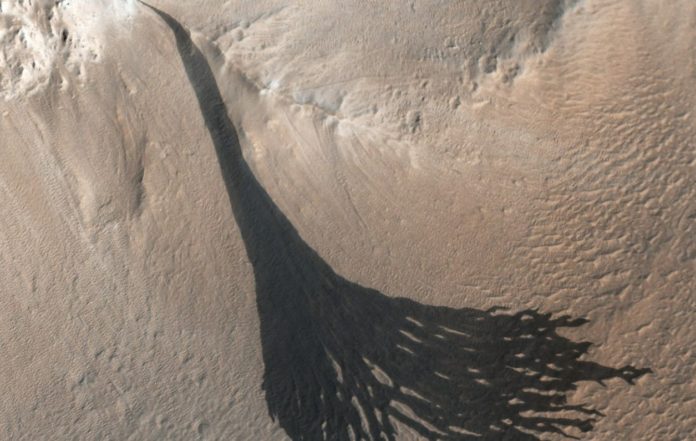New research based on data from NASA’s Mars Odyssey spacecraft could explain why Martian frost is often imperceptible to the human eye and why dust avalanches occur on some slopes.
When scientists saw photographs of the Martian landscape obtained at dawn by NASA’s Mars Odyssey orbiter last year, they were perplexed. They could see ghostly, blue-white morning frost highlighted by the rising Sun when they peered at the surface with visible light – the kind that the human eye senses. The frost showed more extensively when the orbiter’s heat-sensitive camera was used, even in locations where none was visible.
The researchers understood they were dealing with frost that forms overnight and is primarily composed of carbon dioxide – essentially, dry ice, which appears as frost on Mars rather than wet ice. But why could this dry ice frost be seen in some areas but not others?
These scientists provided a startling answer in a report published this month in the Journal of Geophysical Research: Planets, which could also explain how dust avalanches, which are altering the planet, are started after sunrise.
Odyssey is NASA’s longest-running Mars mission, having launched in 2001 and carrying the Thermal Emission Imaging System (THEMIS), a temperature-sensitive infrared camera that provides a unique perspective of the Martian surface. At 7 a.m. local Mars time, Odyssey’s precise orbit provides a unique view of the planet.
“Odyssey’s morning orbit produces spectacular pictures,” says Sylvain Piqueux of NASA’s Jet Propulsion Laboratory in Southern California, who led the paper. “We can see the long shadows of sunrise as they stretch across the surface.”
Because Mars has such a thin atmosphere (about 1% that of Earth), the Sun quickly heats frost that accumulates overnight. Dry ice vaporizes into the atmosphere in minutes rather than melting.
Lucas Lange, a JPL intern working with Piqueux, first spotted the frost’s cold-temperature signal in several areas where it wasn’t visible on the surface. These temperatures were only tens of microns below the surface, less than the breadth of a human hair “below.”
“Our first thought was ice could be buried there,” Lange adds. “Dry ice is plentiful near Mars’ poles, but we were looking closer to the equator of the planet, where it’s generally too warm for dry ice frost to form.”
The authors speculate that they were witnessing “dirty frost” — dry ice frost combined with small dust grains that hid it in visible light but not infrared imaging.
The scientists speculated that dirty frost could possibly explain some of the dark streaks that can stretch 3,300 feet (1,000 meters) down Martian slopes. They understood the streaks were caused by dust avalanches, which steadily change mountain ranges around the world. These dust avalanches are thought to resemble a ground-hugging river of dust that leaves a trail of fluffy material behind. The dust exposes streaks of darker material beneath it as it goes downhill over several hours.
These dark streaks are not the same as the better-known repeating slope lineae, which appear in the same locations year after year, for weeks (rather than hours) at a time. Previously considered to be caused by saline water slowly trickling down from mountainsides, repeating slope lineae are now thought to be caused by dry sand or dust flows.
When the authors were mapping the slope streaks for their new study, they discovered that they exist in places where there is morning frost. The streaks, according to the researchers, were caused by vaporizing frost exerting just enough pressure to release the dust grains, resulting in an avalanche.
The theories offer more proof of the Red Planet’s unpredictable nature.
“Every time we send a mission to Mars, we discover exotic new processes,” adds Chris Edwards, a paper co-author at Northern Arizona University in Flagstaff. “We don’t have anything exactly like a slope streak on Earth. You have to think beyond your experiences on Earth to understand Mars.”
Image Credit: Getty
You were reading: Scientists say evaporating dirty frost triggers avalanches on Mars
